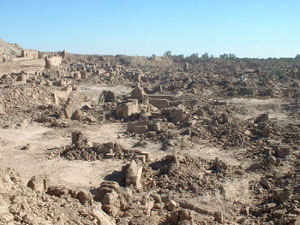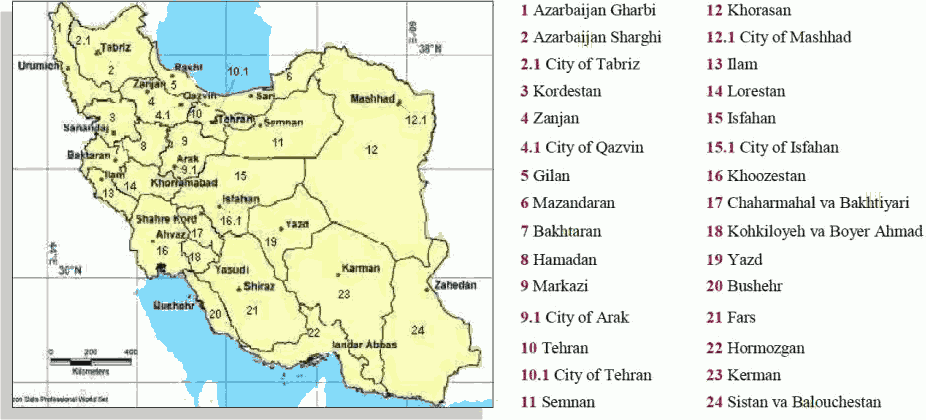Iran, the Bam disaster
This region is, therefore, particularly vulnerable to seismic activities. The fragility of infrastructures and buildings prevent Iran from withstanding the fallout of big earthquakes that hit the country periodically.
 © Ales Kocourek, CC BY-SA 3.0 © Ales Kocourek, CC BY-SA 3.0 |
The Bam Earthquake
The December 26, 2003 Bam earthquake is just the tip of the iceberg for all the regions located on one of the world's most important faults stretching from Greece to South-East Asia. Measuring 6.3 on the Richter scale, this last earthquake claimed the lives of about 45 000 people and wrecked over 70% of the dwellings of Bam city and neighbouring villages.
 According to a Bimeh Markazi official, about 3 000 people holders of a life policy perished in the disaster, mainly government clerks and teachers. Along with life policies involved in the disaster, property damage is considerably high and includes public offices, banks, companies and houses. The first insurance companies losses are estimated to range between 120 and 150 billion Iranian Rials (14 to 18 million USD).
According to a Bimeh Markazi official, about 3 000 people holders of a life policy perished in the disaster, mainly government clerks and teachers. Along with life policies involved in the disaster, property damage is considerably high and includes public offices, banks, companies and houses. The first insurance companies losses are estimated to range between 120 and 150 billion Iranian Rials (14 to 18 million USD).
Doctors Mohsen Aboutorabi, professor of architecture in London and Amid Khadir of Montreal justified the full scale of the devastation caused by the Bam earthquake not only by the fact that the houses were built of earth bricks, but also by the fact that after their fall, these bricks turned into dust, blocking air pockets that would otherwise have made it possible for the trapped victims to breathe.
According to Dr. Bahran Akaseh, professor at the Teheran university and government adviser in seismology, a 6.3 earthquake would be deadlier than that of Bam if it was to hit the region of Teheran where the soil is too crumbly. He adds that a big earthquake in Teheran would claim the lives of 6% of the city's population estimated to be 12 million, and would destroy 80% of the dwellings. According to the statistics of Teheran crisis prevention and management bureau, the capital suffers an average major earthquake every 150 years, with the last one dating back to 1830.
Earthquake insurance in Iran
Insurance terms
Earthquake guarantee can be underwritten with fire base policy through the issue of an endorsement. Industrial and commercial risks must include an earthquake guarantee.
Earthquake risk is generally insured on the basis of 100% of the sum insured for fire.
Legal cession
All Iranian insurance companies are bound to give in 25% of non-life policies and 50% of life policies to the benefit of Bimeh Markazi.
Rating
Earthquake pricing is done according to 5 zones from 1 to 5. It takes into account the geographical zone and the type of construction.
Industrial and commercial risk rating (rates in ‰)
| Construction | Zone 1 | Zone 5 |
|---|---|---|
Wood | 0,8 | 1,6 |
Brick | 0,6 | 1,4 |
Concrete | 0,4 | 1,0 |
Code 2800* | 0,2 | 0,8 |
The rate in use for private houses is of 1‰ throughout the country.
Major earthquake Chronology
in millions USD| Year | Location | Magnitude (Richter scale) | Death toll | Damages |
|---|---|---|---|---|
| 1957 | Babel | 7.1 | 1 200 | ND |
| 1962 | Sagzabed | 7.3 | 12 000 | 12 |
| 1968 | Khorasan | 7.4 | 12 100 | 40 |
| 1972 | Fimzabad | 7.0 | 5 044 | 5 |
| 1978 | Tabas | 7.7 | 20 000 | 11 |
| 1990 | Rasht/Gilan | 7.7 | 40 000 | 7 100 |
| 1997 | Bojnurd/Shirvan | 6.1 | 88 | ND |
| 1997 | Ardabil | 5.5 | 800 | ND |
| 1997 | Ardekul/Birjand | 7.1 | 1 560 | 500 |
| 2002 | Quazvin | 6.3 | 227 | 300 |
| 2003 | Bam | 6.3 | 45 000 | ND |
C.R.E.S.T.A 1map
CRESTA split Iran up into 24 zones :

1 C.R.E.S.T.A
Set up in 1977, CRESTA is an independent and private organisation that manages natural risks coverage.
CRESTA is not a regulatory body, but is in charge of data collection and of disseminating information.
Its objective is to standardize natural disaster underwriting procedures.
CRESTA gathers data on the countries'physical features and draws maps representing the geographical zones of each country according to the natural risks accumulation.